Shaula, Lambda Scorpii (λ Sco), is a triple star system located at a distance of about 570 light years from Earth in the direction of the constellation Scorpius. With an apparent magnitude of 1.62, it is the second brightest star in Scorpius, fainter only than the red supergiant Antares. It marks the Scorpion’s stinger with its fainter neighbour Lesath.
Shaula is part of the Fish Hook, a bright asterism that makes the constellation Scorpius stand out in the sky. The Fish Hook is formed by the stars that outline the celestial Scorpion’s body, tail and stinger.
Star system
Lambda Scorpii is a multiple star system composed of two hot, blue B-type stars and a faint pre-main sequence companion. The three stars probably formed at the same time, as they lie in the same orbital plane.
The primary component, Lambda Scorpii Aa (Shaula), is a hot blue-white subgiant star of the spectral type B2IV. The star has either already stopped fusing hydrogen in its core or will soon do so. Due to its high mass, it will probably end its life as a supernova.
Shaula has a mass of 10.4 solar masses and a radius 8.8 times that of the Sun. With an effective temperature of around 25,000 K, it shines with 36,300 solar luminosities. The star is an exceptionally fast spinner. With a projected rotational velocity of 150 km/s, it takes about 3.4 days to complete a rotation.
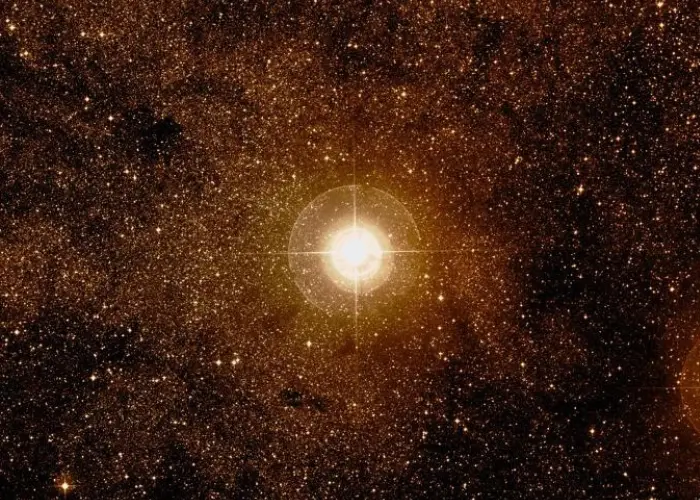
Shaula (Lambda Scorpii), image: Wikisky (DSS)
The pre-main sequence star, Lambda Scorpii Ab, orbits the primary component with a period of 5.9520 days. It has a mass of 1.8 solar masses. Unlike Shaula, it is not a supernova candidate. It has an apparent magnitude of 14.9 and is separated by 4 arcseconds from the primary. Some sources list the star as a white dwarf of the spectral type DA7.9.
The more distant Lambda Scorpii B orbits Shaula with a period of 2.8825 years (1,053 days) at an average separation of about 5.7 astronomical units. The star has 8.1 times the Sun’s mass and a radius 4.7 times that of the Sun. Like the primary component, it has a surface temperature of 25,000 K.
Other sources give masses of 14.5, 2.0 and 10.6 solar masses for the three components.
Lambda Scorpii A is classified as a Beta Cephei-type variable. It is a variable star that exhibits small, rapid changes in brightness – about a hundredth of a magnitude – due to pulsations of its surface. Its brightness varies with two periods, 0.2137 and 0.1069 days.
The pulsations are caused by an abundance of iron deep beneath the surface, where the temperature reaches 200,000 K, causing the iron to increase in opacity. As a result, there is a subsurface build-up of energy that increases pressure and pushes the layers out over several hours.
Beta Cephei variables (or Beta Canis Majoris variables) are typically evolved stars with masses of 7 – 20 solar masses. Other bright stars in this class include Alfirk (Beta Cephei) in the constellation Cepheus, Girtab (Kappa Scorpii) and Alniyat (Sigma Scorpii) in Scorpius, Hadar (Beta Centauri) and Epsilon Centauri in Centaurus, Mimosa (Beta Crucis) and Imai (Delta Crucis) in Crux, Spica (Alpha Virginis) in Virgo, Mirzam (Beta Canis Majoris) in Canis Major, Algenib (Gamma Pegasi) in Pegasus, Eta Orionis in Orion, Alpha Muscae in Musca, Alpha Pyxidis in Pyxis, Alpha Lupi in Lupus, and Delta Ceti in Cetus.
The Lambda Scorpii star system has an estimated age of only 10 – 13 million years. Even though the stars are relatively young, they have already reached the end of their main sequence lifetime due to their high mass. It will not be long (astronomically speaking) before the two more massive components reach the end of their life cycle and end their lives either as brilliant supernovae or massive white dwarfs.
Facts
Shaula is one of the bright Scorpius stars that form the Fish Hook. The Fish Hook is a bright, conspicuous asterism also formed by Antares, Alniyat (Sigma Scorpii), Paikauhale (Tau Scorpii), Larawag (Epsilon Scorpii), Xamidimura and Pipirima (Mu1 and Mu2 Scorpii), Zeta Scorpii, Eta Scorpii, Sargas (Theta Scorpii), Iota1 Scorpii, and Kappa Scorpii. The asterism is part of the constellation figure of Scorpius. It outlines the Scorpion’s heart (Antares), body, tail and stinger.
At declination 42 – 43° S, Sargas, Eta and Zeta Scorpii – the southernmost stars of the Fish Hook – are challenging targets for observers in the mid-northern latitudes. While they are theoretically visible from locations south of the latitude 47° N, they always stay close to the southern horizon when observed from mid-northern locations.
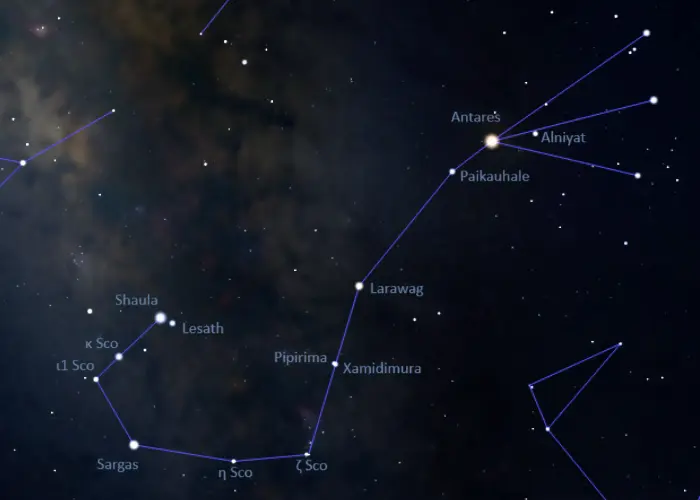
The Fish Hook, image: Stellarium
Shaula and Lesath (Upsilon Scorpii) mark the Scorpion’s stinger. The fainter Lesath shines at magnitude 2.70 and lies approximately 580 light-years away. Like Shaula, it is a supernova candidate, with a mass 11.4 times that of the Sun. The two stars appear close in the night sky and form a visual pair sometimes called the “Cat’s Eyes.”
Shaula is the 24th brightest star in the sky. It is only slightly fainter than Regulus in the constellation Leo, Adhara in Canis Major and Castor in Gemini, and it just outshines Gacrux in Crux, Bellatrix in Orion, and Elnath in Taurus.
Shaula and its brighter neighbour Antares are among the 58 stars selected for navigation. Navigational stars are some of the brightest and most recognizable stars in the sky. They play a special role in the field of celestial navigation.
Shaula is the third brightest second-magnitude star. Only Adhara, the second brightest star in the constellation Canis Major, and Castor, the second brightest star in Gemini, are brighter.
Shaula is one of the stars featured on the flag of Brazil. Each star symbolizes a Brazilian Federative Unit and Shaula represents the state of Rio Grande do Norte.
In fiction, Lambda Scorpii was memorably used in The Transformers comic book series. Cybertron, the Transformers home world, orbits the star in the IDW comics.

Shaula (Lambda Scorpii) and Lesath (Upsilon Scorpii) mark the Scorpion’s stinger. Image: Wikisky (DSS)
Name
The name Shaula (pronunciation: /ˈʃɔːlə/) is derived from the Arabic al-šawlā´ (al-shawlah), “the raised (tail),” referring to the star’s position in the Scorpion’s tail. It was officially approved for Lambda Scorpii Aa by the International Astronomical Union’s (IAU) Working Group on Star Names (WGSN) on July 20, 2016. The name formally applies only to the primary component, Lambda Scorpii Aa (Shaula A).
The star’s traditional Chinese name is also a reference to the Tail (尾宿). The star is known as the Eighth Star of the Tail (尾宿八). In Chinese astronomy, Shaula forms an asterism called Tail with Xamidimura (Mu1 Scorpii), Larawag (Epsilon Scorpii), Zeta1 Scorpii, Zeta2 Scorpii, Eta Scorpii, Sargas (Theta Scorpii), Iota1 Scorpii, Iota2 Scorpii, Kappa Scorpii (Girtab), and Lesath (Upsilon Scorpii). The asterism is part of the larger Tail mansion, which represents the tail of the Azure Dragon.
Shaula and its fainter neighbour Lesath (Upsilon Scorpii) are listed in the Babylonian astronomical compendium MUL.APIN as dSharur4 u dShargaz (Sharur and Shargaz). In Coptic, they were known as Minamref, meaning “the Sting.”
The Boorong people in northwestern Victoria in Australia called the pair Karik Karik, meaning “the Falcons.” The Pawnee people of the Central Plains associated Shaula and Lesath with the coming of spring. The Spring Awakening ceremony was held when the two stars appeared in the southeastern sky before dawn in February. The stars were known as the Swimming Ducks.
In Indian astronomy, Shaula is known as MulA Nakshathram. In Vedic astrology, Mūla (meaning “root”) is the 19th lunar mansion (nakshatra). It is symbolized by a bunch of roots tied together.
Location
As the name suggests, Shaula marks the Scorpion’s stinger. It lies at the end of the Scorpion’s tail together with Lesath, Upsilon Scorpii.
Shaula is part of the Fish Hook, which appears west of the Teapot in Sagittarius. Both asterisms appear in the field of the Milky Way’s bright band and can be used to find the many deep sky objects that lie in this region of the sky.
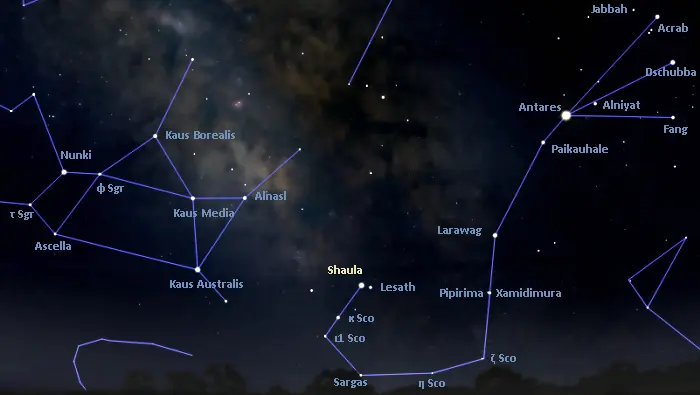
The location of Shaula (Lambda Scorpii), image: Stellarium
Shaula lies in an area populated by a number of interesting deep sky objects. These include the Ptolemy Cluster (Messier 7), one of the brightest open clusters in the sky, NGC 6441, one of the most massive and luminous globular clusters in our galaxy, the diffuse nebula NGC 6357, nicknamed the Lobster Nebula or War and Peace Nebula, the Prawn Nebula (IC 4628), a vast emission nebula, and the Cat’s Paw Nebula (NGC 6334), an emission nebula named for its striking resemblance to a cat’s footprint.
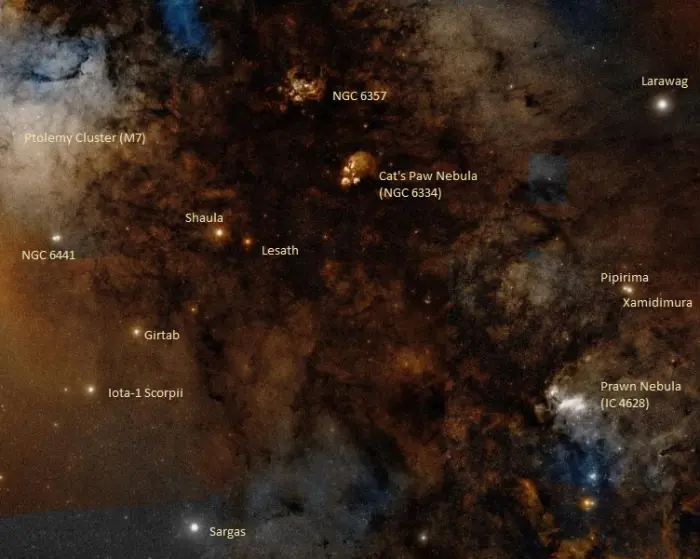
The deep sky objects near Shaula, image: Wikisky (DSS)
Constellation
Shaula is located in the southern constellation Scorpius, one of the most recognizable constellations in the sky. Like all zodiac constellations, Scorpius was first catalogued by the Greco-Roman astronomer Ptolemy in the 2nd century AD. In Greek mythology, the constellation represents the scorpion that stung Orion, the mythical hunter.
Scorpius is the 33rd largest constellation in the sky, stretching across an area of 497 square degrees of the southern sky. It is also one of the brightest constellations. It hosts the red supergiant Antares, the 15th brightest star in the sky, and five second-magnitude stars: Shaula, Sargas, Dschubba, Larawag, and Kappa Scorpii. These stars form two prominent asterisms – the Fish Hook and the Scorpion’s claws – that make Scorpius very easy to identify on a clear night.
Other notable stars in Scorpius include the multiple star systems Sigma Scorpii (Alniyat) and Beta Scorpii (Acrab), the hot blue subgiant Lesath (Upsilon Scorpii), the F-type supergiant Iota1 Scorpii and A-type supergiant Iota2 Scorpii, the B-type supergiant Zeta1 Scorpii and orange giant Zeta2 Scorpii, and the recurring nova U Scorpii.
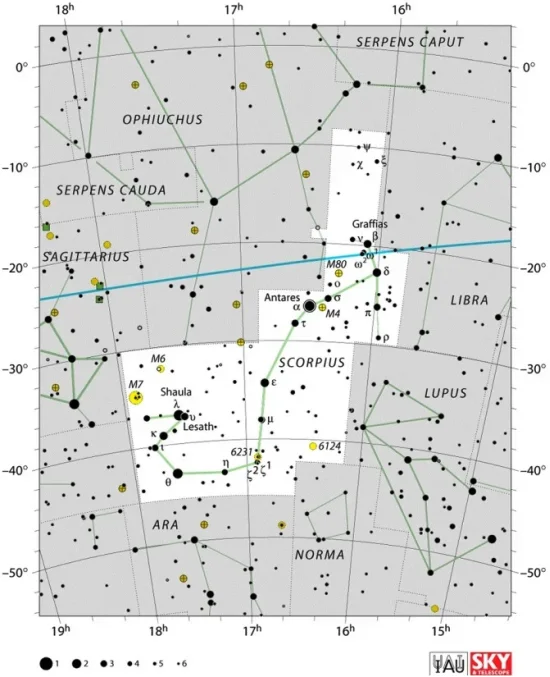
Scorpius constellation map by IAU and Sky&Telescope magazine (Roger Sinnott & Rick Fienberg) (CC BY 4.0)
Scorpius also hosts the massive star system Pismis 24-1, the yellow hypergiant IRAS 17163−3907, the candidate luminous blue variable Wray 17-96, one of the most luminous stars known, and the variable red supergiant AH Scorpii, one of the largest stars known.
The constellation lies in a rich area of the Milky Way in the direction of the Galactic Centre and contains a number of notable star clusters and nebulae. In addition to those already mentioned, Scorpius is home to the bipolar planetary Butterfly Nebula (NGC 6302), the star cluster Messier 4, one of the nearest globular clusters to the Sun, the globular cluster Messier 80, and the open clusters Messier 6 (the Butterfly Cluster), Messier 7 (the Ptolemy Cluster), NGC 6281, and NGC 6231 (the Northern Jewel Box Cluster.)
The best time of the year to observe Shaula and other stars and deep sky objects in Scorpius from the northern hemisphere is in the summer, when the constellation appears higher above the horizon in the early evening. South of the equator, Scorpius is best seen in the months of winter and spring. The entire constellation is visible from locations south of the latitude 40° N.
The 10 brightest stars in Scorpius are Antares (Alpha Sco A, mag. 0.6 – 1.6), Shaula (Lambda Sco A, mag. 1.62), Sargas (Theta Sco A, mag. 1.84), Dschubba (Delta Sco, mag 2.307), Larawag (Epsilon Sco, mag. 2.31), Kappa Scorpii (mag. 2.39), Acrab (Beta Sco, mag. 2.62), Lesath (Upsilon Sco, mag. 2.70), Paikauhale (Tau Sco, mag. 2.82), and Fang (Pi Sco, mag. 2.89).
Shaula – Lambda Scorpii
| Spectral class | B2IV + DA7.9 or B1.5IV + B2IV |
| Variable type | Beta Cephei (λ Sco A) |
| U-B colour index | -0.880 |
| B-V colour index | -0.240 |
| Apparent magnitude | 1.62 (λ Sco A) / 14.9 (λ Sco B) / 12.0 (λ Sco C) |
| Absolute magnitude | -3.70 |
| Distance | 570 light years (80 parsecs) |
| Parallax | 5.71 ± 0.75 mas |
| Radial velocity | -3.00 ± 2.8 km/s |
| Proper motion | RA: -8.53 ± 1.08 mas/yr |
| Dec.: -30.80 ± 0.62 mas/yr | |
| Age | 10 – 13 million years |
| Constellation | Scorpius |
| Right ascension | 17h 33m 36.52012s |
| Declination | -37° 06′ 13.7648” |
| Names and designations | Shaula, Lambda Scorpii, λ Sco, 5 Scorpii, HD 158926, HR 6527, HIP 85927, SAO 208954, FK5 652, PPM 296488, GC 23769, GCRV 10136, CD -37 11673, CPD-37 7265, CPC 18 8791, ALS 15082, 1E 1730.2-3704, GSC 07388-01093, UBV 14937, TIC 465088681, JP11 2862, PMC 90-93 462, IRAS 17302-3704, 2MASS J17333652-3706135, EUVE J1733-37.1, TYC 7388-1093-1, CCDM J17336-3706A/B/C, IDS 17268-3702 A, WDS J17336-3706A, WDS J17336-3706Aa,Ab |
Lambda Scorpii Aa
| Mass | 10.4 M☉ |
| Luminosity | 36,300 L☉ |
| Radius | 8.8 ± 1.2 R☉ |
| Temperature | 25,000 ± 1,000 K |
| Rotational velocity | 150 km/s |
| Rotation | 3.4 ± 0.5 days |
| Surface gravity | 3.8 cgs |
Lambda Scorpii Ab
| Mass | 1.8 M☉ |
Lambda Scorpii B
| Mass | 8.1 M☉ |
| Radius | 4.7 ± 1.0 R☉ |
| Temperature | 25,000 ± 1,000 K |
| Surface gravity | 4.0 cgs |